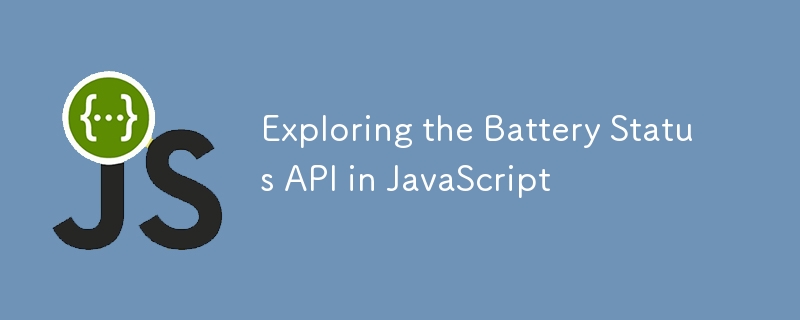
TheBattery Status APIprovides web developers with the ability to access information about the battery status of the device on which their web application is running. By leveraging this API, you can enhance user experience by adapting your application's behavior based on the battery's charge level, charging status, and time remaining until discharge or full charge.
As mobile usage continues to dominate the web, optimizing web applications for battery efficiency has become increasingly important. The Battery Status API enables developers to access vital information about the device's battery, allowing them to make informed decisions that can prolong battery life and improve the overall user experience.
The API provides four key properties:
In this article, we will explore how to use these properties in JavaScript to build more battery-aware applications.
The Battery Status API is supported by most major browsers, although it is primarily available on mobile devices. As of the time of writing, the API is fully supported in the following browsers:
However, it's important to note that due to privacy concerns, the Battery Status API has been deprecated and is no longer widely supported in modern browsers. This makes understanding its usage valuable primarily for legacy systems or custom applications.
The first step in using the Battery Status API is to check the battery's current charge level. You can access this information by querying the navigator.getBattery() method, which returns a Promise that resolves to a BatteryManager object.
navigator.getBattery().then(function(battery) { console.log(`Battery Level: ${battery.level * 100}%`); });
In this example, the battery.level property returns a value between 0.0 and 1.0, representing the charge level as a percentage.
You can also determine whether the device is currently charging by checking the battery.charging property, which returns a boolean.
navigator.getBattery().then(function(battery) { if (battery.charging) { console.log("The device is currently charging."); } else { console.log("The device is not charging."); } });
This information can be crucial for making decisions about when to perform energy-intensive tasks.
The Battery Status API also allows you to monitor changes in battery status, such as when the device starts or stops charging or when the battery level changes. This can be achieved by adding event listeners to the BatteryManager object.
navigator.getBattery().then(function(battery) { function updateBatteryStatus() { console.log(`Battery Level: ${battery.level * 100}%`); console.log(`Charging: ${battery.charging}`); console.log(`Charging Time: ${battery.chargingTime} seconds`); console.log(`Discharging Time: ${battery.dischargingTime} seconds`); } // Initial battery status updateBatteryStatus(); // Add event listeners battery.addEventListener('chargingchange', updateBatteryStatus); battery.addEventListener('levelchange', updateBatteryStatus); battery.addEventListener('chargingtimechange', updateBatteryStatus); battery.addEventListener('dischargingtimechange', updateBatteryStatus); });
This approach ensures that your application remains responsive to battery status changes in real-time, allowing you to optimize performance dynamically.
One practical use case for the Battery Status API is implementing a power-saving mode in your web application. For instance, if the battery level drops below a certain threshold, you might reduce the frequency of background tasks, limit animations, or disable resource-intensive features.
navigator.getBattery().then(function(battery) { if (battery.level < 0.2 && !battery.charging) { enablePowerSavingMode(); } }); function enablePowerSavingMode() { console.log("Enabling power-saving mode..."); // Reduce the frequency of background tasks, disable animations, etc. }
Another use case is to adapt the content loading strategy based on the battery status. For example, you could delay non-essential downloads or switch to lower-quality media streams if the battery is low.
navigator.getBattery().then(function(battery) { if (battery.level < 0.5 && !battery.charging) { loadLowResolutionMedia(); } }); function loadLowResolutionMedia() { console.log("Loading lower resolution media to save battery..."); // Implement logic to load lower quality content }
You can also use the Battery Status API to customize notifications. For instance, if the battery is low, you might want to prioritize important notifications over less critical ones.
navigator.getBattery().then(function(battery) { if (battery.level < 0.3 && !battery.charging) { sendCriticalNotificationsOnly(); } }); function sendCriticalNotificationsOnly() { console.log("Sending only critical notifications..."); // Implement logic to filter and send critical notifications }
While the Battery Status API offers several potential benefits, it also comes with limitations:
Privacy Concerns: The API can be used to infer information about the user's device and habits, leading to privacy concerns. This has resulted in its deprecation in many browsers.
Limited Support: As mentioned earlier, support for the Battery Status API has been removed from most modern browsers due to privacy issues.
Battery Reporting Variability: The accuracy of the reported battery status can vary across devices and may not always reflect the exact state of the battery.
Given these considerations, it's important to use this API with caution and to consider alternative approaches for achieving similar functionality, especially in modern web development environments.
The Battery Status API, while now largely deprecated, provides a unique way to create more battery-efficient web applications by allowing developers to respond to changes in battery status. Although its use is limited by privacy concerns and browser support, it serves as an interesting case study in how web technologies can interact with device hardware to enhance user experience.
If you're working with legacy systems or exploring web capabilities for specific environments, understanding and experimenting with the Battery Status API can still offer valuable insights.
위 내용은 Exploring the Battery Status API in JavaScript의 상세 내용입니다. 자세한 내용은 PHP 중국어 웹사이트의 기타 관련 기사를 참조하세요!